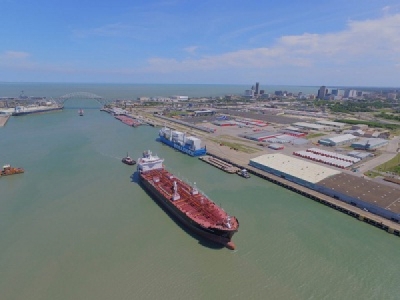
Posted on November 30, 2017
Texas crude oil is being shipped worldwide at ever higher rates as foreign markets get used to the taste of light sweet crude. Port Corpus Christi, a major refining center on the U.S. Gulf Coast, is now becoming a major hub for U.S. crude oil exports.
More than 70 percent of the crude oil moved into Port Corpus Christi in October was exported said Jarl Pedersen, the Port’s chief commercial officer, who was speaking at the Hart Energy’s DUG Eagle Ford Conference held earlier this month at the Convention Center in San Antonio.
That oil is not just coming from South Texas’ Eagle Ford Shale but also from the prolific Permian Basin oil field in West Texas. The exports are making the port, which has a major refining presence on the Gulf Coast, look at different ways to support exports.
“How do we, as a port authority, provide producers access to world markets?” Pedersen asked as he spoke at a panel Friday. “It’s a great opportunity right now to export U.S. crude oil. We want to make sure that producers, marketers, they have optionality, flexibility.”
Oil exports were banned for almost 40 years until December 2015, when Congress voted to lift the prohibition. San Antonio-based NuStar Energy made the first known crude oil export from Port Corpus Christi weeks later. Since then, exports have grown as high as 1.8 million barrels a day in October, a record according to the Federal Reserve Bank of Dallas.
Pedersen said two projects that are underway will help the port take more advantage of oil exports in the coming years. A new $809 million bridge over the port’s entrance is under construction and will allow taller vessels to enter the port, while an agreement to start a $327 million dredging project to deepen and widen the ship channel was recently signed.
Together the projects would allow very large crude carriers with a capacity of upward of 2 million barrels of oil to enter the port empty and leave fully laden. Currently such vessels have to leave the port partly filled, and complete loading offshore.
The first VLCC to dock at a Gulf Coast port occurred in May when Occidental Petroleum docked one such vessel at its Ingleside Energy Center Terminal, which can load upward of 300,000 barrels of crude oil a day.
The bridge and dredging projects are estimated to be completed by 2021, Pedersen said.
The Dallas Fed’s data shows the Eagle Ford Shale has seen production level off around 1.2 million barrels a day, down from more than 1.5 million barrels a day in early 2015.
Production in the Permian Basin, on the other hand, has continued to grow steadily to nearly 2.6 million barrels a day, reflecting continued investment into the oil field. At one point, some deals for acreage in the Permian were worth $60,000 an acre.
But while the Permian has been described as “hot” for much of the past two years, the calmness in the Eagle Ford is attracting some companies, said Stuart Traver, an executive director at Houston-based oil and gas consultancy Gaffney, Cline & Associates.
“There’s another group of buyers that just doesn’t want to engage in such a heavy competition,” Travers said. “We’re seeing people who are looking at the Eagle Ford and the Bakken as sort of a way to avoid some of the heavy competition that goes on in some of the other basins.”
Traver pointed to the lifting of the crude oil export ban in 2015 as why his firm is “bullish” on the Eagle Ford.
“In the future the markets for the Eagle Ford are likely to be overseas,” he said. “That’s why people we work with from overseas like the Eagle Ford.”
Source: Hellenic Shipping News





